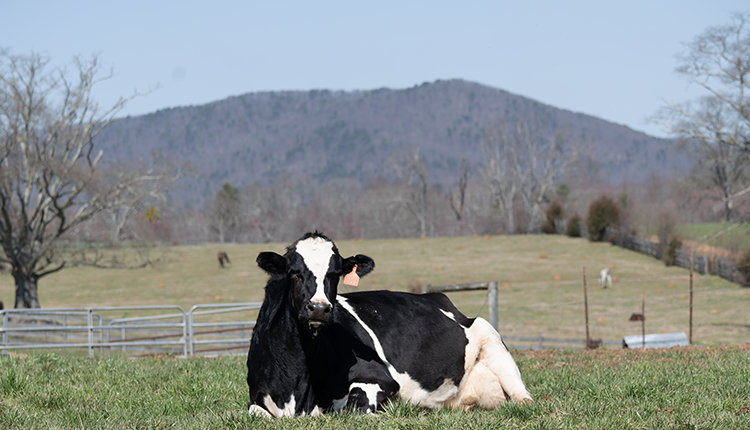
One year ago, the trait Feed Saved made its debut in the December 2020 genetic evaluations published by the Council on Dairy Cattle Breeding (CDCB). With this new trait, dairy can breed for more feed-efficient cows – to save on feed costs and reduce dairy’s environmental footprint.
Right out of the gate, Feed Saved generated great interest among producers and the global dairy breeding community. One year later, we’re pleased to report ongoing progress to improve this important trait.
What is Feed Saved?
Cows vary in the ability to convert feed to milk, and Feed Saved documents those differences. The goal is to identify specific cows that eat less than expected while maintaining production and body condition.
Feed Saved represents the expected pounds of feed saved per lactation based on Body Weight Composite and Residual Feed Intake. Larger positive values represent more pounds of feed saved and indicate a more feed-efficient cow. Feed Saved was incorporated into the national genetic index, Net Merit, in August 2021.
It is difficult and expensive to measure and evaluate individual animals. To develop genomic evaluations, the necessary data – daily feed intake, milk yield, milk composition, body weight, and body condition score – must be measured for a genotyped reference population.
How has the trait improved in the last year?
We have more data now than we did when Feed Saved was first released – from 6,200 records in December 2020 to almost 8,600 records in December 2021. That’s a near 40% gain in records in just a year.
Feed intake data continues to be collected at the five U.S. research herds and added to the CDCB database as available. CDCB and Foundation for Food and Agriculture Research (FFAR) are funding this project to collect additional genotypic and phenotypic records at Michigan State University, University of Wisconsin-Madison, Iowa State University, University of Florida, and USDA Animal Genomics and Improvement Laboratory.
In April 2021, feed intake records from more than 650 lactations in three Canadian herds were added to the reference population.
With these new data, we have been able to conduct additional analyses and determine appropriate adjustments. Similar adjustments are applied in most other traits and recommended especially when combining domestic and foreign data. This larger dataset was also used to re-estimate the heritability. This higher heritability reflects the whole dataset, including the records most recently collected, and will result in more accurate genetic (reliable) predictions. With these new learnings, the Residual Feed Intake Trait has been improved for the next evaluation release on December 7, 2021.
What’s next?
As early as April 2022, thousands of records from additional countries could be added to Residual Feed Intake and Feed Saved. By combining available data, the traits will continue to become more accurate and larger research studies can be conducted.
The U.S. research team is part of a large international effort led by several Canadian research institutions, called the Resilient Dairy Genome Project. Participants share data for traits related to feed efficiency to expand the available reference population. This is especially important for a trait like feed efficiency in which phenotypes are very expensive and labor-intensive to collect, thus resulting in a very small population of animals with phenotypes. We are actively evaluating the data from outside North America to ensure compatibility with our current feed efficiency database.
Continuing flow of new data is another priority, and there are several ways that the team is approaching this challenge. Discussions are actively underway to maintain data collection at the current research herds, and we’re working to recruit additional herds – likely other research farms.
Another strategy being investigated is the identification of proxy variables that could be used in addition to the intensive data currently collected at the research herds. A proxy variable can more easily be collected on a much larger population of animals, and this could be very helpful for a trait like Residual Feed Intake. Research is underway to investigate the impact. Can we reduce the amount of data that is needed, making it more feasible for other farms to collect usable feed efficiency data?
The bottom line
Feed Saved and Residual Feed Intake represent a new type of trait to be included in the Net Merit genetic selection indices. Genomic data allows us to make improvement in the population with phenotypes on only a few thousand animals.
This is quite amazing!
CDCB manages the largest national database of feed efficiency data, and with more data coming in regularly, research is continuing at a very rapid rate. As more data are collected and research completed around the world, we will learn more about the genetics of feed efficiency, and this will result in improvements to the traits over time.
About Net Merit
Net Merit estimates how much lifetime profit each animal will transmit to its progeny. This index drives genetic progress by promoting a balanced selection of all available, economically-important traits to maximize cow profitability. Selection indices like Net Merit are essential tools because they combine information on many traits into a single value to rank animals and make breeding and culling decisions. There are now over 40 traits in Net Merit, such as milk yield, livability, and somatic cell score. Some traits are incorporated through a composite, like calving ability, health dollars, udder, feet and legs and body weight. Developed by animal scientists at USDA, Net Merit is published by the Council on Dairy Cattle Breeding.
About Council on Dairy Cattle Breeding
CDCB drives global dairy cattle improvement by using a collaborative database to deliver state-of-the-art genetic merit and performance assessments for herd decision making. The CDCB is a collaborative effort between four sectors of the U.S. dairy industry: Dairy Records Providers (DRP), Dairy Records Processing Centers (DRPC), National Association of Animal Breeders (NAAB) and Purebred Dairy Cattle Association (PDCA). Read more in the 2021 CDCB Activity Report.








